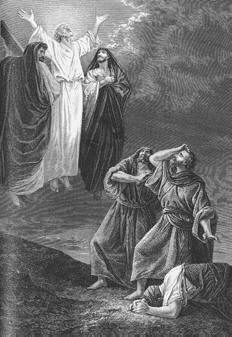Epistles: Eyewitnesses of the Transfiguration (2 Peter 1:13-21)
“I think it is right to refresh your memory as long as I live in the tent of this body” (verses 12-13).
Paul uses the metaphor of a tent as a body (2 Corinthians 5:110); the idea is that a person’s physical body is a temporary housing for a spiritual life. The body will be resurrected (1 Corinthians 15) and God will give us an eternal home (1 Corinthians 15:53; 2 Corinthians 5:1). Peter doesn’t tell us as much as we’d like to know on this topic (nor does Paul), because he has a different purpose: exhorting Christian growth.
Peter also uses the metaphor of tent to describe his own death: “I know that I will soon put it [the tent] aside, as our Lord Jesus Christ has made clear to me. And I will make every effort to see that after my departure you will always be able to remember these things” (2 Peter 1:14-15). As Peter sees that his time of departure draws near (tradition says that Nero had him killed in A.D. 64), he puts his exhortations into writing so that we will have a regular reminder that our Savior wants us to continue to grow.
The basis of authority
 |
| The Transfiguration shows that Jesus had divine glory even before his resurrection; and the glory that Peter saw then made it easier for him to understand and believe Jesus when he promised to return in power and glory. |
Peter also reminds the readers of his basis of authority: “For we did not follow cleverly devised stories when we told you about the coming of our Lord Jesus Christ in power, but we were eyewitnesses of his majesty” (verse 16). We didn’t just make up the stories in an elaborate hoax, he says. Nor are they myths (like Aesop’s fables) designed to teach truth through imaginative events. No, these things about Jesus really happened — we were there, and we saw it.
He then uses the Transfiguration as an example: “He [Jesus] received honor and glory from God the Father when the voice came to him from the Majestic Glory, saying, ‘This is my Son, whom I love; with him I am well pleased’ [Matthew 17:5]. We ourselves heard this voice that came from heaven when we were with him on the sacred mountain” (2 Peter 1:17-18).
Out of all the stories that Peter could have told, why did he pick the Transfiguration, rather than the resurrection or ascension? Perhaps this was the most eye-opening event for Peter — when he heard a distinct voice from God himself. The Transfiguration shows that Jesus had divine glory even before his resurrection; and the glory that Peter saw then made it easier for him to understand and believe Jesus when he promised to return in power and glory.
Peter seems to refer to the Second Coming in the next verses, too: “We also have the prophetic message as something completely reliable, and you will do well to pay attention to it, as to a light shining in a dark place, until the day dawns and the morning star rises in your hearts” (verse 19). Peter points us to the Old Testament prophecies of the Day of the Lord, and we need to live with the knowledge that the day of reward will come.
The prophecies are trustworthy not just because we have seen many of them fulfilled — they are reliable because God caused them to be written. “Above all, you must understand that no prophecy of Scripture came about by the prophet’s own interpretation of things. For prophecy never had its origin in the human will, but prophets, though human, spoke from God as they were carried along by the Holy Spirit” (verses 20-21).
The prophets did not make up their stories, either, and they didn’t always understand how the predictions would be fulfilled. But the prophecies came from God as the Holy Spirit caused them to be written. This does not mean that God dictated the exact spelling of every word, or the precise choice of every word. But the meaning came from God, and the message can be trusted.
Author: Michael Morrison

